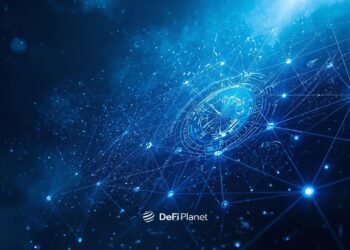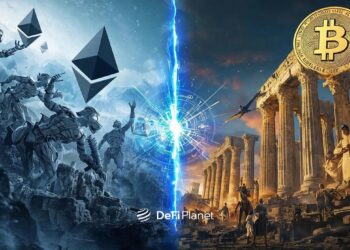Scalability with Ethereum has always been a hurdle that DeFi transactions have had to battle with, because Ethereum’s Layer 1 can only process around 15-30 transactions per second(TPS). This leads to network congestion, slower transaction times, and high gas fees, and to overcome this hurdle, developers have turned to Layer 2 solutions, which are technologies built on Ethereum that seek to enhance blockchain efficiency and performance without compromising security or decentralization. Being the backbone of decentralized applications(dApps), smart contracts and DeFi transactions, Ethereum has had to come up with solutions to resolve these limitations.
Some of the most promising Layer 2 solutions are Optimistic Rollups and Zero-Knowledge(ZK) Rollups, both of which represent different approaches to the same goal of making Ethereum faster and cheaper to use.
What is Layer 2 and Why Does It Matter
Layer 2 is a system or framework built on top of the Ethereum base layer, which is Layer 1, and this is done to help it work faster and more efficiently because rather than making Ethereum process every single transaction, Layer 2 handles most of them off the main network. It then sends a proof or summary of those transactions back to Ethereum, helping to take pressure off the main Ethereum network and leading to quicker transactions that take place at a much lower cost.
As a result, they are crucial for Ethereum scaling and supporting the growing demand in sectors like NFTs, DeFi, and blockchain gaming.
Optimistic Rollups: Speed with a Safety Net
With Optimistic Rollups, transactions are deemed valid until someone proves that they are not, and this is done by grouping; rather than checking every transaction right away, Optimistic Rollups group multiple transactions together and send them to the Ethereum mainnet. If there is no dispute on these transactions over a defined period, which is usually about seven days, then the transactions can be accepted as valid. If it is believed that a mistake was made, a fraud proof can be submitted to correct it.
This helps to reduce the computing power needed to process each transaction, making things faster, cheaper and more efficient. Gas fees are much cheaper, and users can enjoy quicker transactions and do not have to be burdened by the typical disadvantages that come with the use of layer 1 solutions. Popular Layer 2 platforms like Optimism and Arbitrum use this method, and they have become widely used because they work well with Ethereum’s current system, called the Ethereum Virtual Machine(EVM). This compatibility means that developers can move their apps or smart contracts from Ethereum to these rollups without having to rewrite too many lines of code.
They, however, have one significant drawback: due to the fact that there is a challenge window to catch any errors, users typically have to wait, oftentimes up to a week, if they want to transfer funds back to the Ethereum main network. This waiting time can be a problem for people or apps that need quick access to their money.
ZK Rollups: Cryptographic Accuracy and Instant Finality
While Optimistic Rollups might rely on the assumption that transactions are valid until someone proves they are not, ZK Rollups or Zero knowledge Rollups work in a much different way. They use advanced cryptographic proofs, also known as validity proofs, to prove that all the transactions in a batch are correct before sending them to the Ethereum mainnet.
The validity proof is like a scanner that scans all transactions for errors before passing them. Transactions are grouped and processed offchain, and a single proof is generated to confirm that everything has been done correctly. This proof is then submitted to Ethereum, and once it is verified, the transactions are instantly accepted and finalized with a very high level of security.
The main advantage of this is that there is no need to wait for a dispute period like in Optimistic Rollup, and as a result, users can enjoy almost instant finality, which means that once a transaction is confirmed, it is locked in and cannot be changed again. Zero knowledge Rollups are very valuable for fast-paced decentralized finance (DeFi) transactions and those time-sensitive applications where delay could lead to loss or financial risks.
ZK Rollups are also more efficient at compressing data, and they can bundle transactions together in a way that reduces the amount of information that needs to be stored or sent to Ethereum. This feature allows it to be able to handle more transactions at lower gas fees, making it one of the most scalable solutions for Ethereum. Projects like zkSync, StarkNet, and Polygon zkEVM are some of the leading platforms pioneering these next-generation rollup technologies, each offering unique solutions to make blockchain systems faster and more affordable.
They are, however, technically demanding in that the cryptographic proofs involved are highly complex and require specialized knowledge and infrastructure, with many ZK Rollup platforms unable to work natively with the Ethereum Virtual Machine (EVM). This means that developers will need to learn new programming languages or build applications in entirely different environments, which can slow down the adoption and make the development difficult.
With the evolving landscape, projects like zkEVM are being developed to bridge the gap by allowing ZK Rollups to run existing Ethereum smart contracts with little to no modification. This means developers can keep using familiar tools while still benefiting from the speed, cost-efficiency, and finality that ZK Rollups provide. As the technology matures and becomes easier to use, it’s likely that ZK Rollups will play an increasingly important role in Ethereum scaling and the broader blockchain ecosystem.
Comparing Gas Fees and Performance
When you compare the Optimistic and the ZK rollups to the Layer 1 solutions, they fare better and drastically reduce the gas fees by as much as 10 to 100 times, depending on the usage and network conditions. This makes them a better option than Layer 1 and makes them a better choice for mass adoption of Ethereum, especially in high-volume sectors like DeFi transactions and on-chain gaming.
Optimistic Rollups currently have a more mature ecosystem and wider developer adoption than their current counterpart, and their EVM compatibility and lower technical barriers make them a go-to choice for many dApp builders today. Zk rollups have the feature of unmatched speed, scalability and security because of their Zero Knowledge proofs, and this makes them a better edge in performance-sensitive applications.
Cost Comparison: ZK Rollups vs. Optimistic Rollups
ZK rollups are highly efficient in terms of gas fee optimization because they compress transaction data more efficiently, helping to reduce the amount of data that needs to be processed on Ethereum. This results in the ability to handle a large number of transactions while keeping fees lower compared to traditional Ethereum transactions. Also, the cryptographic validity proofs used by ZK Rollups allow for a faster and more efficient transaction validation, helping to minimise the resources required for Ethereum to verify data, leading to lower long-term operational costs.
Optimistic Rollups, in contrast, seek to lower fees by assuming that transactions are valid and only require additional computation if there is a dispute during the challenge period. This could introduce other costs even while it reduces the computational overhead, as they often have to maintain the infrastructure to manage the dispute resolution process, which can add complexity and costs over time.
However, Optimistic Rollups still offer cost savings when used in non-time-sensitive applications, as the lower transaction validation costs during normal operations generally outweigh the potential challenge costs. If a user wants to withdraw funds from the rollup to Ethereum Layer 1, they will have to wait for the challenge window to expire, which can result in higher withdrawal costs due to the delay.
Both ZK Rollups and Optimistic Rollups offer significant cost savings compared to Ethereum’s Layer 1. ZK Rollups are generally more efficient, especially for high-throughput applications. On the other hand, Optimistic Rollups can still be cost-effective but may incur higher fees during dispute resolution and delays in withdrawals.
ETH 2.0 and the Future of Layer 2
While “ETH 2.0” is no longer an official term, Ethereum is undergoing upgrades that directly support Layer 2 growth. The Merge, which shifted Ethereum from proof-of-work to proof-of-stake, was just the beginning, with upcoming changes like Danksharding, which aims to make Ethereum more data-efficient by increasing the capacity to store and process rollup proofs on-chain.
These upgrades will significantly reduce the cost and complexity of Layer 2 operations, making both Optimistic and ZK Rollups more effective. As Ethereum evolves, rollups are expected to become the primary way users interact with the network, handling the majority of transactions while Layer 1 becomes a secure settlement layer.
Vitalik Buterin, Ethereum’s co-founder, has even stated that ZK Rollups are likely the long-term solution for Ethereum scaling due to their superior efficiency and trustless architecture. However, he also acknowledges that Optimistic Rollups will continue to dominate in the near term because of their current maturity and ease of use.
The Path Ahead
The Layer 2 “scaling wars” aren’t a matter of picking a single winner. Instead, both Optimistic Rollups and ZK Rollups are expected to coexist and serve different niches within Ethereum’s rapidly growing ecosystem. Their innovations make Ethereum far more scalable and cost-effective, opening the door to mainstream use without compromising decentralization.
In the coming years, we can expect further enhancements in rollup interoperability, user experience, and tooling. As Ethereum continues to scale, it’s likely that most users will interact with Layer 2 solutions by default, never needing to worry about high gas fees or slow confirmation times again.
For developers, understanding the strengths and limitations of each rollup type will be critical to choosing the right tool for their application. And for users, these scaling solutions mean faster, cheaper, and more secure interactions across the Ethereum network.
Disclaimer: This article is intended solely for informational purposes and should not be considered trading or investment advice. Nothing herein should be construed as financial, legal, or tax advice. Trading or investing in cryptocurrencies carries a considerable risk of financial loss. Always conduct due diligence.
If you want to read more market analyses like this one, visit DeFi Planet and follow us on Twitter, LinkedIn, Facebook, Instagram, and CoinMarketCap Community.
Take control of your crypto portfolio with MARKETS PRO, DeFi Planet’s suite of analytics tools.”





















